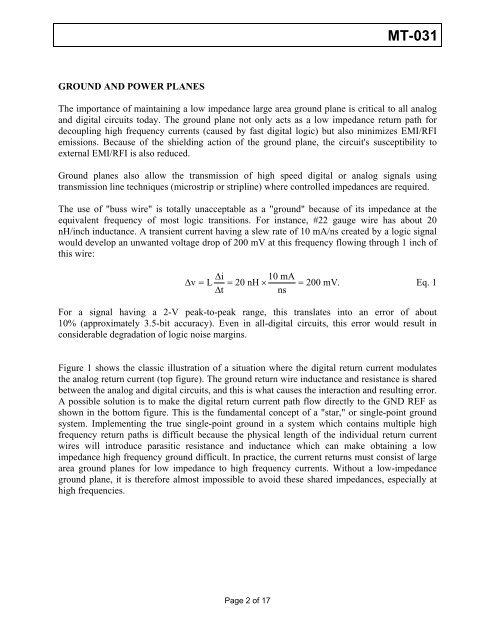MT-031: Grounding Data Converters and Solving ... - Analog Devices
MT-031: Grounding Data Converters and Solving ... - Analog Devices
MT-031: Grounding Data Converters and Solving ... - Analog Devices
Create successful ePaper yourself
Turn your PDF publications into a flip-book with our unique Google optimized e-Paper software.
GROUND AND POWER PLANES<br />
<strong>MT</strong>-<strong>031</strong><br />
The importance of maintaining a low impedance large area ground plane is critical to all analog<br />
<strong>and</strong> digital circuits today. The ground plane not only acts as a low impedance return path for<br />
decoupling high frequency currents (caused by fast digital logic) but also minimizes EMI/RFI<br />
emissions. Because of the shielding action of the ground plane, the circuit's susceptibility to<br />
external EMI/RFI is also reduced.<br />
Ground planes also allow the transmission of high speed digital or analog signals using<br />
transmission line techniques (microstrip or stripline) where controlled impedances are required.<br />
The use of "buss wire" is totally unacceptable as a "ground" because of its impedance at the<br />
equivalent frequency of most logic transitions. For instance, #22 gauge wire has about 20<br />
nH/inch inductance. A transient current having a slew rate of 10 mA/ns created by a logic signal<br />
would develop an unwanted voltage drop of 200 mV at this frequency flowing through 1 inch of<br />
this wire:<br />
Δi<br />
10 mA<br />
Δ v = L = 20 nH × = 200 mV.<br />
Eq. 1<br />
Δt<br />
ns<br />
For a signal having a 2-V peak-to-peak range, this translates into an error of about<br />
10% (approximately 3.5-bit accuracy). Even in all-digital circuits, this error would result in<br />
considerable degradation of logic noise margins.<br />
Figure 1 shows the classic illustration of a situation where the digital return current modulates<br />
the analog return current (top figure). The ground return wire inductance <strong>and</strong> resistance is shared<br />
between the analog <strong>and</strong> digital circuits, <strong>and</strong> this is what causes the interaction <strong>and</strong> resulting error.<br />
A possible solution is to make the digital return current path flow directly to the GND REF as<br />
shown in the bottom figure. This is the fundamental concept of a "star," or single-point ground<br />
system. Implementing the true single-point ground in a system which contains multiple high<br />
frequency return paths is difficult because the physical length of the individual return current<br />
wires will introduce parasitic resistance <strong>and</strong> inductance which can make obtaining a low<br />
impedance high frequency ground difficult. In practice, the current returns must consist of large<br />
area ground planes for low impedance to high frequency currents. Without a low-impedance<br />
ground plane, it is therefore almost impossible to avoid these shared impedances, especially at<br />
high frequencies.<br />
Page 2 of 17
















